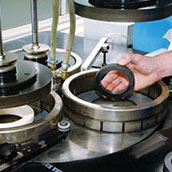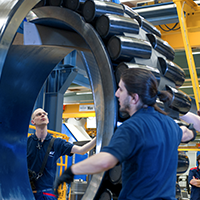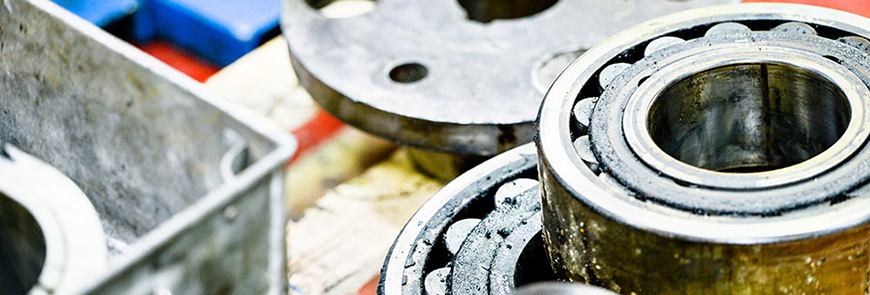
Engineering Basics: Guide to Bearings
Designed to enable rotational or linear movement in a device, bearings are machine elements that are used to reduce friction between moving parts and to enhance the speed and efficiency of a system. At the same time, bearings are used to support other parts of a machine by handling various amounts of stress.
When two metal parts come in contact inside a machine, a large amount of friction is produced, and this can lead to the wear and
tear of the material in time. Bearings reduce friction and facilitate movement by having two surfaces that roll over each other.
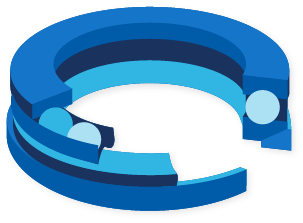 Depending on the design of the bearing, these surfaces may vary, but in general bearings are made of two rings or discs with
raceways, rolling elements like rollers or balls that roll against the inner and outer metal surfaces, and a cage which keeps
the rollers apart and guides them.
Depending on the design of the bearing, these surfaces may vary, but in general bearings are made of two rings or discs with
raceways, rolling elements like rollers or balls that roll against the inner and outer metal surfaces, and a cage which keeps
the rollers apart and guides them.
Resembling wheels, bearings have two key functions inside a system: they enable the transfer of motion by allowing components to
turn relative to one another, and they transmit forces by sliding or rolling. The load acted upon a bearing can be radial or
thrust load, depending on the bearing construction.
The purpose of this guide is to help you get familiar with the most common types of bearings, their design particularities and
operating mode, the way they handle forces, the proper installation and maintenance procedures, as well as the most frequent
problems that can cause the damage of bearings inside a machine.
1. Classification of bearings
Bearings can be classified based on different criteria, such as design and operating mode, allowed motion or direction of load.
From a design perspective, bearings can be classified into:
Plain bearings –
Also referred to as bushes, bushings or sleeve bearings, these are the simplest type of bearings. With a cylindrical shape and no
moving parts, they are usually used in machines with a rotating or sliding shaft component. Plain bearings can be made of metal or
plastic and can use a lubricant like oil or graphite for reducing the friction between the shaft and the hole it rotates in.
Typically, they are used for sliding, rotation, oscillating or reciprocating motion.
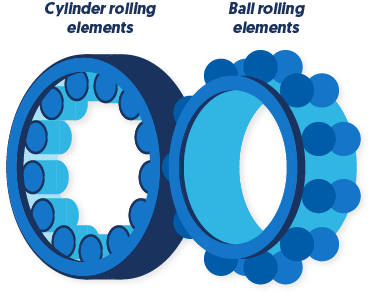
Rolling-element bearings -
These bearings have a more complex design and are used for supporting higher loads. They consist of rolling elements such as
balls or cylinders which are placed between a turning and a stationary race. The relative motion of the races causes
the movement of the rolling elements, with little friction and little sliding.
Depending on the shape of the rolling elements, these bearings can be further classified into ball bearings and roller bearings,
with various sub-types: cylindrical roller bearings, spherical roller bearings, tapered roller bearings, needle roller bearings
and gear bearings.
Fluid bearings - As their name suggests, these bearings
contain a layer of fluid between the bearing surfaces. The fluid can be either a pressurized liquid or a gas, and is distributed
in a thin layer which moves rapidly between the internal and external races. Since the bearing surfaces have no direct contact,
there is no sliding friction in this type of bearings, therefore the overall friction and wear of these components is much lower
than in rolling-element bearings.
Magnetic bearings - These bearings make use of magnetic
levitation for supporting the loads, which means there is no surface contact within the bearing. By eliminating friction and the
wear of materials, magnetic bearings have a much longer life and can support the highest speeds of all types of bearings. These
components are often preferred in industrial applications like petroleum refinement, natural gas handling or electrical power
generation, but also in optical systems with high rotational speeds and in vacuum applications.
We’ll discuss the most common types of bearings more in detail in the next chapters of this guide, but right now we’ll continue with
the classification of bearings.
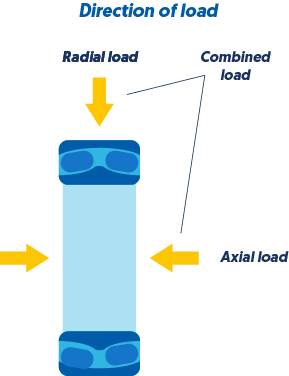
Another criterion for categorizing bearings is the direction of the load they can accommodate. From this point of
view, bearings are grouped into three main categories: radial bearings, thrust bearings and linear bearings.
The contact angle between the bearing and the shaft determines the type of bearing: radial bearings have a contact angle
under 45°, while thrust bearings have a contact angle above 45°.
Linear bearings
guide the moving parts in a straight line. They are also referred to as linear guides and come in two main shapes: round and square.
Radial bearings can support loads that
fall perpendicularly to the shaft. Depending on the design, they may also accommodate some axial loads, in one or two directions.
Radial bearings are installed perpendicularly to the axial line of the shaft. Plain bearings - also called journal bearings - are
often used as radial bearings.
Thrust bearings support loads that are parallel to the bearing axis, so they are designed to withstand
forces in the same direction as the shaft (axial loads).
Depending on their design, these bearings can handle pure axial loads in
one or two directions, and sometimes also some radial loads, but unlike radial bearings, these components cannot accommodate very
high speeds.
NOTE: Given that both plain and rolling-element bearings can transmit loads in radial and axial
directions, the choice of bearing design depends on the application requirements.
![]() Wide assortment of bearings and accessories
Wide assortment of bearings and accessories
In our webshop you will find a wide variety of bearings, along with housings and lubricants. Explore our full assortment of
bearings from top brands like SKF, FAG, INA, NSK and TIMKEN, and find the right product for your
application.
2. Plain bearings design and applications
As previously said, there are two main types of bearing constructions: plain bearings and rolling-element bearings. Let's see
which are the most common sub-types for each of these categories, and what are the differences between them in terms of design,
materials and applications.
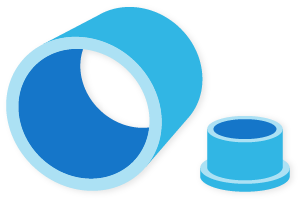
Plain bearings are made of a single bearing surface, with no rolling parts. The design depends on the type of motion required, and on
the load that the bearing has to withstand. These machine components are quieter in operation than rolling-element bearings, have a
lower cost and require less space.
On the other hand, they have a higher friction between the surfaces, which can lead to a higher
power consumption in the machine, and are more susceptible to damage if impurities get into the lubricant.
Plain bearings can be made from different materials, but they have to be durable, low wear and low friction, resistant to
temperatures and corrosion. Often, the bearing surfaces are made of at least two components of which one is softer and one is harder.
Common materials include babbitt, a bi-material that consists of a metal shell and a plastic bearing surface, cast iron, bronze, graphite,
as well as ceramics and plastics.
Although plain bearings often require lubrication, they are - at least theoretically - capable of running indefinitely, so they
can be used in applications where the failure of these components would lead to severe consequences. For example, large industrial
turbines like power plant steam turbines, compressors operating in critical applications, automotive engines, marine applications
and so on.
In what concerns the main types of plain bearings, from a structural point of view there are three important categories:
sleeves or bushings, integral bearings and two-piece plain bearings. Another classification of plain bearings categorizes them into
hydrodynamic and hydrostatic bearings.
Spherical plain bearings
Spherical plain bearings have an inner ring with a convex outside surface and an outer ring with a concave inside surface.
The two rings are mounted together, so there are no rolling elements in between. However, depending on the materials used for the
rings, a layer of coating can be applied for reducing the wear.
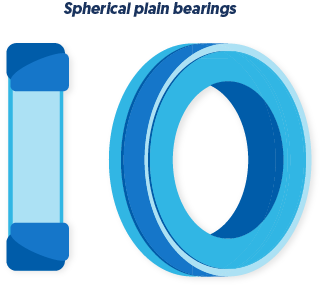
Bearings in which both rings are made of steel require maintenance, as they have hardened sliding contact surfaces on
both rings. These are coated with materials like molybdenum disulphide, hard chromium or phosphate, which increase the wear and
corrosion resistance. To facilitate relubrication, these bearings feature lubrication holes and an annular groove.
Spherical plain bearings that require maintenance (steel-on-steel) are suitable for applications where heavy loads of
alternating direction, heavy static loads or shock loads are involved.
Maintenance-free spherical plain bearings are intended for application where a long and maintenance-free bearing life is needed,
for example in machines and assemblies where relubrication would be difficult. These bearings are usually made of materials like
steel and PTFE composite, PTFE fabric or copper alloy. The ability to withstand dynamic loads is higher than in steel-on-steel bearings,
and thanks to the used materials, these bearings have lower friction.
Depending on the materials, the outer ring can be pressed around the inner ring or can have or can have radial splits
which are held together by screws. The contact surfaces can be coated with chromium, PTFE or phosphate, to increase wear and corrosion
resistance. In some designs, seals can be added to reduce contamination and extend the bearing life.
Spherical plain bearings are suitable for applications where alignment movements between the shaft and housing have to be
accommodated. When they can withstand heavy loads and shocks, they are also referred to as heavy-duty spherical plain bearings.
Rod ends
Rod end bearings, also referred to as Rose joints or Heim joints,
consist of an eye-shaped head with integral shank, which is used as housing for a spherical plain bearing. The internal thread is usually
left- or ring-hand female, while the external thread is male.
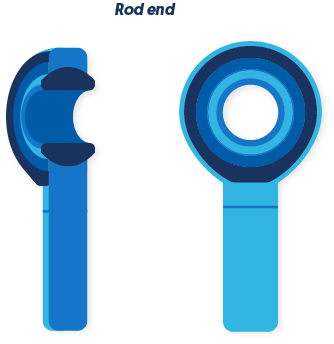
The bearing is fixed inside the housing, so unlike spherical plain bearings, which offer misalignment capabilities, rod ends
don't have this characteristic. They are, however, very easy to mount, provide a compact and lightweight design and are a good alternative
to a conventional housing element. Rod end bearings are often used in control rods, mechanisms and linkages, being easy to integrate in
various applications.
Just like spherical plain bearings, rod ends can be maintenance-free or can require maintenance. Steel-on-steel and steel-on-bronze
rod ends have good wear-resistant sliding surfaces, but require regular lubrication. They are suitable for applications where heavy
alternating loads are involved.
In what concerns maintenance-free rod end bearings, these are usually made of materials like steel and PTFE
composite or steel and PTFE fabric, in this case the friction forces being much lower. These bearings are suitable for applications
where a long bearing life is required, where relubrication would be difficult and where the loads have a constant direction.
Bushings
The most common type of plain bearing is the bushing
or bush, which is an independent element inserted into a housing to provide a supporting surface. The shape is usually cylindrical,
the standard configurations being the sleeve bearing and the flanged bearing. Sleeve bearings have straight inside
and outside surfaces and equal diameters, while the flanged ones have a flange at one end that is used for locating the element in
an assembly, and sometimes also for covering the mounting holes and securing the bearing in place.
Additionally, plain bearings can be lined, in this case a different material being used for the inside and outside
surfaces. Bushings are used for linear, oscillating and rotating movements, the straight sleeves being suitable for radial loads,
while the flanged bushings are able to withstand radial and axial loads in one direction.
Unlike rolling-element bearings, plain bearings – including bushings – function via a sliding action. Their construction
can be single- or multi-layered, depending on the needed strength. Plain bearings are made from a variety of materials, and are
often self-lubricating, this particularity ensuring a smoother operation and greater durability.
The most common materials used for bushings are cast and machined metals, ceramics, fiber-wound composites, stabilized
polymer materials and combinations of these. As for lubricants, both solid and fluid ones can be used, but the solid lubricants can
usually operate at higher temperatures than oil- or grease-based ones. For some applications, bushings run dry, with no additional
lubrication.
The construction of bushings can be solid or with a split or clench. The difference between the solid and the split
bushing (wrapped bearing) is that the latter features a cut along its length, for easier installation. The clenched bearing is
similar to the split one, but has a clench across the cut connecting the parts.
In general, linear bushings are not pressed into a housing, but secured with retaining rings or with rings that are
molded into the outer diameter of the bushing. When bushings are used similarly to washers, they are called thrust washers.
However, there is a difference between them: unlike standard spacers or washers, thrust washers must carry a load and shouldn’t
wear out over time.
Self-lubricating bushings
A particular type of bushing is the self-lubricating one, in which a solid lubricating film is created inside the bearing through
transfer of a small amount of surface material. This happens in the initial run-in period of the bearing, but the amount of
material transferred is small enough to not interfere with the functioning and load-handling properties of the bearing.
The film is in contact with all the moving parts of the device, lubricating and protecting them, therefore it helps in extending
the service life of the bearing. By doing so it eliminates the need of extra lubrication and reduces the costs with maintenance.
Self-lubricating bushings have the advantage of being more lightweight thanks to the thinner walls, and of heaving excellent wear
resistance. They can withstand high loads and have a simplified design that makes them more economical in the long run.
Two-piece plain bearings
Also referred to as full bearings, two-piece plain bearings are used in industrial machinery where larger diameters are required,
such as crankshaft bearings. They are made of two parts called shells, which are kept in place using different mechanisms.
If the shells are large and thick, a button stop or a dowel pin can be used for locating them. The button stop is screwed
on the housing, and the dowel pin links the two shells together. Another possibility is to use a tab on the parting line edge that
corelates with a notch in the housing, to prevent the movement of the shells after installation.
3. Rolling-element bearings design and applications
Rolling-element bearings are also called antifriction bearings, as they have lower friction and reduced lubrication requirements
compared to plain bearings. Their role is to support and to guide rotating and oscillating machine elements, such as shafts, wheels
or axels, and to transfer loads between the different components of an assembly.
They come in standard sizes, are easy to replace and cost-effective. By minimizing friction and enabling high rotational speeds,
these bearings reduce the heat and energy consumption, leading to more efficient processes.
Antifriction bearings usually consist of two raceways – an inner ring and an outer ring, rolling elements
which can be balls or rollers, and a cage that separates the rolling elements at specific intervals and keeps them in place
inside the raceways, while enabling them to rotate freely.

The raceways are the components of a bearing that support the loads placed on the device. When a bearing is mounted in
an assembly, the inner ring of the bearing fits around the shaft or axle, while the outer ring fits on the housing.
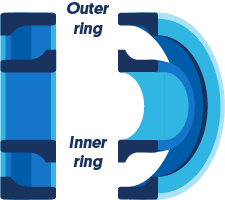
The rings are usually made of special chrome alloy steel with a high purity and hardness, and are hardened, ground and
honed. Ceramic and plastic materials may also be used, especially in sectors where a lighter weight may be necessary – for example,
in the automotive industry. Still, these materials cannot withstand the same temperatures or loads as steel.
The cage holds the rolling elements in place and prevents them from falling out when the bearing is handled. Thanks to
the design of the bearing, the load is never applied directly on the cage. This component can be manufactured using different
methods, but the common types include pressed, formed and machined cages. As for materials, usual options include steel, plastic
and brass.
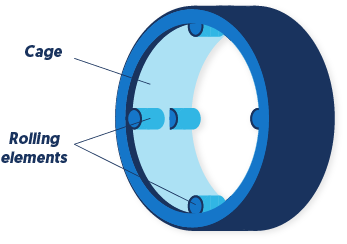
Finally, the rolling elements fall into two main categories, that distinguish also the basic types of rolling bearings:
ball elements, which are found in ball bearings, and rollers, which are found in roller bearings. In case of balls, the contact
with the raceways is in specific points, while for rollers the contact surfaces are slightly bigger and linear.
These particularities make ball bearings more suitable for applications where higher speeds are needed, as the small
contact areas provide low rolling friction. However, ball bearings have a limited load-carrying capacity, so in case of
applications where heavier loads are involved, roller bearings may be preferred. Thanks to their larger contact with the raceways,
roller bearings have higher friction and better load-bearing capacity, but lower speeds.
The rollers can come in the shape of cylinders, cones, spheres or needles, and are made from high purity chrome alloy
steel, just like the balls. Sometimes, special materials like ceramics or plastic can also be used.
Ball bearings
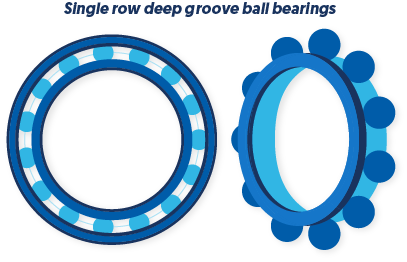
Ball bearings are classified into two main groups, depending on the configuration of the rings: deep groove ball bearings and
angular contact ball bearings. Both types can withstand radial and axial forces, therefore they can be further classified into
radial ball bearings and thrust ball bearings.
Another classification criterion includes the number of rolling rows – single, double or four row, and the separation
or lack of separation between the rings.
Considering all these criteria, we can distinguish several models of ball bearings:
single row deep groove ball bearings,
single row angular contact ball bearings,
double row angular contact ball bearings,
four-point contact ball bearings,
self-aligning ball bearings,
single direction thrust ball bearings and so on.
Ball bearings are used in a variety of applications, from simpler devices like skateboards to complex machines or engines. In the
aerospace industry for example, bearings can be used in gearboxes, engines and pulleys. The materials these bearings are made of
can include not only steel but also special ceramics like silicon nitride or titanium-carbide coated 440C stainless steel.
Other common applications of ball bearings include electric motors and generators, pumps and compressors, blowers, fans, gear boxes
and drives, turbines, farm machinery, conveying systems, oil field machinery, robotics, industrial valves and so on.
Deep groove ball bearings
Ball bearings are the most common type of rolling-element bearing, and from these, the most used ones are deep
groove ball bearings. These are radial bearings which can have a single or a double row of balls, and come in different
construction types, such as Conrad type or slot-fill radial bearings.

The name of these compounds is given by the deep grooves formed on the inner and outer rings. In the Conrad design, the
inner ring is initially placed into an eccentric position relative to the outer one, and the balls are inserted into the bearing
through the gap that forms between the two rings.
Once they are distributed evenly in the bearing assembly, the rings become concentric, therefore the cage can also be
added to the bearing. The role of the cage, as previously mentioned, is not to support loads, but to keep the balls in place during
operation.
The inner ring is usually fastened to the rotating shaft, while the outer ring is mounted onto the bearing housing. When
a load is applied on the bearing housing, it is transmitted from the outer race to the balls, and from the balls to the inner race.
Deep groove ball bearings are suitable for applications where high loads and speeds are involved.
In the slot-fill design, more balls can be assembled between the two rings, therefore the radial load capacity of the bearing is
higher than in the Conrad bearings. However, the axial load-bearing capacity of these components is not that good.
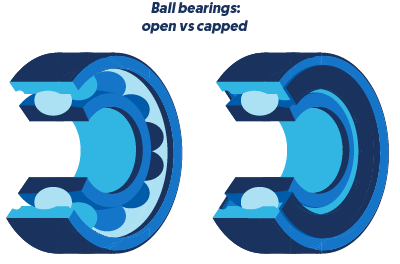
Deep groove ball bearings are available as open type bearings that allow for easy lubrication, but have the disadvantage that
the balls can collect dust. An alternative construction is the bearings with metal shields and / or seals, where the contamination
is moderate. Bearings with shields or seals on both sides are lubricated for life, therefore require minimum to no maintenance.
Bearings with shields or seals are also called capped bearings. Although the design may vary, the seals are fitted in general on the
outer ring, and can come in the form of non-contact seals, low-friction seals or shields.
Shields are used in applications where the inner ring rotates and are fitted on the outer ring, forming a narrow gap with
the inner ring. They protect from dust and dirt and are generally made of sheet steel. Seals are generally more effective than
shields as they create smaller gaps with the inner rings. They can be operated at speeds similar to shields or higher, and are made
of sheet steel reinforced NBR or similar materials, which are resistant to wear.
As for the cages in deep groove ball bearings, their construction can also vary, but some common designs are ribbon-type
cages made of steel or brass sheets, riveted cages of brass sheet or steel, machined brass cages or snap-type cages made of
polyamide 6,6.
To conclude, deep groove ball bearings are versatile devices, suitable for high and very high speeds, robust in operation and
requiring little maintenance. They can accommodate radial loads and axial loads in both directions and in the single-row design,
deep groove ball bearings are the most widely used type of bearing.
Angular contact ball bearings
Angular contact ball bearings also come in various designs, being available as single or double row, matched pair or four-point
contact bearings. Their construction allows these elements to withstand both axial and radial forces, therefore they are suitable
for applications with high loads and speeds.

Unlike deep groove ball bearings, angular ones use axially asymmetric races, the contact angle between the rings and the balls
being formed when the bearing is in use. A particularity of these bearings is that one or both of the ring races – typically the
outer ring - have one shoulder higher than the other.
These bearings function properly when assembled with a thrust load. The contact angle usually varies between 10 and 45 degrees, and
when this angle increases, the thrust capacity also increases.
Angular contact bearings can come in different design styles, with seals or shielding. These serve not only as protection
from contamination but also as retainers for lubricants. These bearings can be made from stainless steel, ceramic hybrid materials
or plastic, and may be plated with chrome, cadmium or other materials. Also, they can be pre-lubricated, re-lubricated or can
feature solid lubrication.
Roller bearings
Roller bearings are classified into different types depending on the shape of the rolling elements. The main categories of roller bearings include cylindrical bearings, needle bearings, tapered bearings and spherical roller bearings.
CYLINDRICAL ROLLER BEARINGS
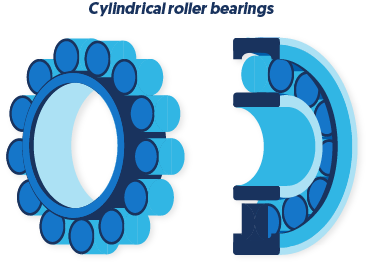
Cylindrical roller bearings are engineered to withstand heavy radial
loads and moderate thrust loads, and they contain cylindrically-shaped rollers designed to reduce stress concentrations.
The rollers are in linear contact with the raceways, and are usually made of steel. Materials like polyamide or brass
can also be used in cylindrical roller bearings for the cages.
These types of bearings have low friction and long service life, low noise and heat generation, and can be used in
applications where high speeds are involved. Cylindrical roller bearings come in different styles, the designations varying depending
on the manufacturer.
These bearings can be classified based on the number of roller rows. From this point of view, these machine components are divided
into single row cylindrical roller bearings, double row and four row cylindrical roller bearings. In the single row models, for
all designations, the inner and outer rings are separable, meaning that the inner ring with roller and the cage assembly can be
mounted independently of the outer ring.
Depending on the design, the rings can come with or without ribs, so they can move axially relative to each other. There are also
models available with no cage, and in this case they function with a full complement of rollers, which allows for higher loads but
lower speeds.
Cylindrical roller bearings are often used in industries like petroleum production, power generation, mining,
construction equipment, gears and drives, electric motors, blowers, fans, as well as pumps, machine tools and rolling mills.
SPHERICAL ROLLER BEARINGS
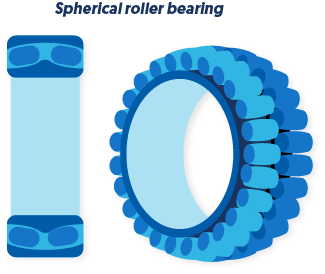
Spherical roller bearings are suitable for low to medium speed applications,
and can withstand heavy loads. Given that they are self-aligning, they are used in applications with severe misalignment,
vibration and shocks, as well as in contaminated environments.
Usually made of alloy steels, brass, polyamide or low-carbon steels, these bearings are also available in
chrome-plated models.
The rotating shaft supported in the bore of the inner ring can be misaligned in respect to the outer ring, this particularity being
possible thanks to the spherical internal shape of the outer ring and to the shape of the rollers, which aren’t actually spherical
but cylindrical.
Robust and designed for heavy radial loads, these bearings have a long service life and low friction. They are typically used in
applications like gearboxes, pumps, mechanical fans and blowers, wind turbines, marine propulsion and offshore drilling, mining and
construction equipment and so on.
In what concerns the design of these bearings, they have an inner ring with two raceways inclined at an angle to the bearing axis,
a cage and an outer ring with a common spherical raceway. The spherical rollers are most commonly distributed in two rows, this
design allowing the bearings to withstand very heavy radial and axial loads.
Spherical roller bearings can run at lower temperatures compared to other bearings, and they come in standardized sizes, the
international norm for these devices being ISO 15:1998. Common series include 21300, 22200, 22300, 23000, 23100, 23200 and so on.
Spherical bearings are available with sealings and are delivered lubricated. This design reduces grease, protects against
dirt, dust and other contaminants and simplifies maintenance, extending the service life of the bearings.
SPHERICAL ROLLER THRUST BEARINGS
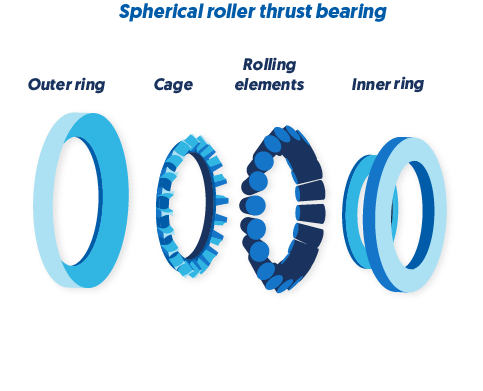
Similarly to spherical roller bearings, spherical roller thrust
bearings are designed to permit angular misalignment and rotation with low friction, being suitable for radial loads and heavy
axial loads in one direction.
These bearings are made of a shaft washer which is the equivalent of the inner ring, a housing washer which is the
equivalent of the outer ring, asymmetrical rollers and a cage. The external dimensions are standardized by the norm ISP 104:2002,
the most common series including 292, 293 and 294.
Just like spherical roller bearings, the thrust bearings can be made of different materials, such as chrome steel, brass, sheet
steel and so on. These bearings are used in applications with moderate speeds, some common applications being water turbines,
gearboxes, cranes, marine propulsion and offshore drilling, extruders for injection molding and pulp and paper processing equipment.
NEEDLE ROLLER BEARINGS
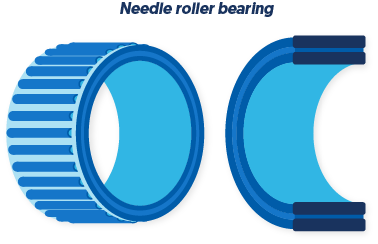
In needle roller bearings, the rolling elements are shaped like thin cylinders that resemble needles. This particular design, in
which the length of the rollers is a few times higher than the diameter, not only makes them stand out from other types of bearings
but also gives needle roller bearings a significant load-bearing capacity.
Used for reducing the friction of a rotating surface within an assembly, needle roller bearings have a small cross-sectional height,
are thinner than other bearings and require less clearance between the axle and the surrounding elements.
With greater rigidity and lower inertia forces acting on them, these bearings are ideal for applications with oscillating motion
and perform well under severe conditions. They also facilitate size and weight reductions in machine designs and can serve as
replacements for sliding bearings.
The smallest and lightest of the roller bearing family, needle roller bearings are widely used in the automotive industry, in
components such as compressors, transmissions, rocker arm pivots or pumps. These bearings are also commonly used in agricultural
applications and construction equipment, in portable power tools and domestic appliances.
In what concerns the different types of needle roller bearings, these are classified into radial and thrust bearings, depending on
the direction of the load. Thrust bearings include thrust needle bearings, while radial ones include drawn cup bearings, solid needle
roller bearings, radial caged needle rollers, track rollers, heavy-duty machined needle roller bearings, and combined radial and
thrust bearings.
Solid needle roller bearings feature an outer ring with
strong integrated ribs which keep the rollers in place and ensure high operating speeds. The ring is precisely ground after being
heat treated, therefore can withstand high shock loads. The cage is also treated to increase the wear resistance and rigidity, and
if needed, crowning can be applied to reduce the loads on the roller edges. The outer ring features a lubrication hole or groove
that makes it easy to replace the lubricant, extending the life of the bearing.
Radial caged needle rollers or needle roller and cage
assemblies have no inner or outer ring, their design consisting only of a complement of needle rollers that are held in place by
a cage. This cage provides inward and outward retention for the rolling elements and ensures maximum strength as well as accurate
guidance for the rollers even at high speeds.
Radial caged needle rollers have a low cross section, a high load-carrying capacity, and their design creates favorable
lubricating conditions. The cage can be made of steel or of glass-reinforced polymer material, and if needed, crowning can be
applied on both ends of the rollers to prevent stress concentrations at the edges. Common applications include planetary gears,
idler gears and connecting rods.
Drawn cup needle bearings are available as caged and full
complement models, both of them featuring an outer ring which is made of alloy steel sheet. This shell is accurately drawn in the
form of a cup and surface-hardened through pressing, so it ensures a tight line contact with the rollers. This construction gives
the bearing a high load-carrying capacity, and because no additional machining is needed for the shell, it also makes it an
economical solution.
Drawn cup needle bearings have a low height which makes them suitable for compact and lightweight machine designs. The bent parts
of the outer ring keep the rollers in place and prevent dust and dirt from entering the bearing, while also ensuring good bearing
lubrication. Another advantage of this design is that if the shaft has proper hardness and dimensions, the bearing doesn’t require
an internal ring, therefore more space can be saved in the radial direction.
The full complement drawn cup needle bearings can carry loads equal to or higher than ball and roller bearings of comparable outer
diameters, and are suitable for static, slow rotating and oscillating conditions. They can be used in housings of low hardness, and
have maximum load capacity when the rollers are held in place by grease before assembly, as the rollers have the longest possible
length.
In what concerns the drawn cup caged bearings, they can also be used in housings of low hardness but have a lower load capacity
than full complement ones. Still, they are excellent for high speed and shaft misalignment applications. The surface of the cage
is hardened therefore the wear resistance and the rigidity are increased, while the frictional torque is reduced.
As the cage creates some extra space for storing lubricant, these needle bearings operate smoothly and have a long grease life.
Common applications for drawn cup needle roller bearings include gear pumps, general gearbox shaft supports, pilot bearings and
pulley supports.
Track rollers have thick-walled outer rings that run
directly on a track and allow for high loads, while minimizing distortion, shocks and bending stresses. These are commonly used
in machine ways, mast rollers and cam followers, and are also referred to as cam followers.
The outer ring is usually made of high-carbon chromium steel, which is resistant to deformation, and features holes for lubrication.
If needed, crowning can be applied on the rollers to prevent excessive loads at the edges. Also, thrust washers can be integrated
in the design to enhance resistance.
These needle bearings come in two main designs, for different mounting arrangements: yoke type, which is suitable for straddle or
clevis mounting, and integral stud type, suitable for cantilever mounting. The stud type bearings are available with or without lip
contact seals and shields, while the yoke type bearings are available with either radial needle roller and cage assemblies, or with
full complement cylindrical or needle rollers.
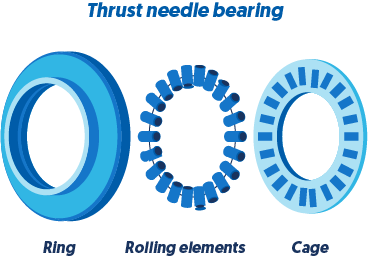
Thrust
needle bearings consist of a complement of needle rollers held in place by a cage. They have small cross sections and the cage
is made of two steel sheets precisely pressed, which guide the rollers accurately and increase the rigidity and wear resistance of
the device. These bearings transmit thrust loads between two rotating objects while reducing friction.
Combined radial and thrust bearings consist of a thrust ball
or roller bearing and a radial needle roller bearing. Some of them are similar to drawn cup bearings, but with an added thrust
bearing. These devices are designed to withstand high speeds and high axial loads in limited spaces, and can be used instead of
plain thrust washers, when superior load capacity and frictional characteristics are needed. A common application is automatic
transmissions.
TAPERED ROLLER BEARINGS
Tapered roller bearings consist of an inner ring or cone, an outer ring or cup, a
cage and rollers which are profiled to distribute the loads evenly. These bearings use conical rollers guided by a rib on the cone,
and are capable of withstanding high radial and axial loads in one direction.
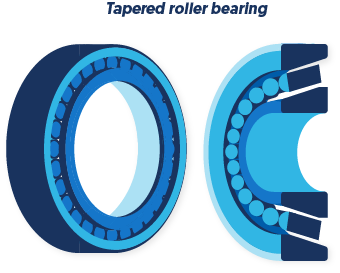
The inner and outer ring raceways are segments of cones, and the rollers are tapered, this design enabling a coaxial motion of the
cones and no sliding motion between the raceways and the outer diameters of the rollers. Thanks to their shape, tapered roller
bearings can support higher loads than spherical ball bearings.
The flange on the inner ring which keeps the rollers stable prevents them from popping out. The inner ring, rollers and cage form
a non-separable cone assembly, while the outer ring is shaped like a cup and separable. The cone assembly and cup can be mounted
independently, and proper internal clearance can be obtained by adjusting the axial distance between these components for two
opposed bearings.
Depending on the contact angle, tapered roller bearings can be classified into three types: normal angle, medium angle and steep
angle. Also, based on the number of rows, they can be classified into:
Single row tapered roller bearings, which have one cup
and one cone assembly. In this category are included the series TS and TSF (single row with flanged outer ring).
Double row tapered roller bearings which use one double cup (outer
ring) and two single cone roller assemblies (inner rings). The TDO series is included here.
Double row tapered roller bearings which use a double-cone
assembly (double inner ring) and two single cups (outer rings). The TDI and TDIT series are included here.
Four rows tapered roller bearings which use a combination of
double and single components, such as two TDI cones, two TS cups and one TDO cup with cup or cone spacers. The TQO series is
included here.
Single-row bearings have a higher thrust load capacity, while double-row bearings have a greater radial load capacity and can
handle thrust loads in both directions. The standard cage is the pin-type design, which can withstand high loads and speeds.
Pressed steel cages are generally used. In many applications, these bearings are used in back-to-back pairs to support axial forces
in either direction.
Additionally, tapered roller bearings are available in metric series:
Metric single row tapered roller bearings, which are in
accordance with the standard ISO 355:2007. These are suitable for gear boxes, pumps and conveyors used in applications for the power
industry, oil and gas, wind energy, food and beverage or pulp and paper industry. Also, they can be used in drive trains, gear drives and axle
centers in the construction, automotive and mining industries.
Metric double row tapered roller bearings, which consist of
two single-row bearings with individually matched spacers. These are used in applications that require high load capacities and where
the shaft must be located axially in both directions with a specific clearance or preload. The outer ring spacer features lubrication holes.
These bearings are suitable for applications like gear drives and transmissions, coal conveyors or cranes.
Common applications for tapered roller bearings include car and vehicle wheel bearings, agriculture, construction and mining
equipment, gear boxes, engine motors and reducers, wind turbines, axle systems and propeller shafts.
4. Lubrication and maintenance of bearings
Proper installation and adjustment plays a vital role in the performance and life of bearings, and so does the lubricant. In
most cases, the failure of bearings is not caused by improper installation or manufacturing defects, but by a lack of lubricant,
an incorrectly chosen or a contaminated lubricant.
The lubricant, be it oil or grease, is spread between the moving parts of a bearing assembly and separates them, reducing friction
and preventing wear. Depending on the operating conditions and on the chosen lubricant, a protective film will form on the bearing
elements, the role of this film being also to dissipate the frictional heat, preventing the deterioration of the bearing and
protecting against moisture, corrosion and contaminants.
A correctly chosen lubricant has the proper additives and viscosity to accomplish all the mentioned goals. The most common
lubricants are oil and grease, the use of one or another being determined by the speed of the application and by the amount of load
placed on the bearings.
In case of oils, the most important characteristic is the viscosity, the proper product being determined by the temperature and
speed of the application. If an oil with insufficient viscosity is used, then the two rotating surfaces will come in contact and
this will not only lead to wear but will also generate contact heat, and will cause the quick degradation of the bearing elements.
The most common oils for bearings are petroleum based and synthetic oils such as silicone, fluorinated compounds, diesters or PAO’s.
Oils are usually chosen for bearings with higher speed capabilities and higher operating temperature, as they can carry the heat
away from the bearings. In some cases, such as miniature bearings for example, oil-based lubricants only need to be applied once
for the life of the bearing. In assemblies that use larger bearings, relubrication may be necessary as part of the regular machine
maintenance cycle.
For grease-based lubricants, the most important characteristics are the temperature range, the penetration level, the stiffness and
the viscosity of the base oil. Greases consist of an oil base in which a thickener is added, the most common thickeners being
organic and inorganic compounds, as well as metal soaps like sodium, aluminum, calcium or lithium. Additives with antioxidant,
anticorrosion and anti-wear characteristics can also be incorporated to increase the performance of the lubricant.
Alternatively, a solid non-fluid film can be applied like a coating on the bearing elements to reduce friction and prevent wear.
These films are used in particular situations when oil or grease cannot survive, and they include options like graphite, silver,
PTFE or gold films. For example, in an application with extreme temperatures or radiation, an oil- or grease-based lubricant may not
offer proper protection, therefore a more durable one like a solid film may need to be used.
In most cases, grease is a good choice for lubricating bearings. More cost-efficient than oil, grease is easily retained in the
bearing assembly and is easy to apply. However, it is not suitable for applications where heat removal via circulating oil is
needed, nor in gearboxes where lubricating oil is required.
Also, if the operating conditions require the relubrication of bearings with grease at intervals that are too short, and this
becomes too time consuming and expensive, or if the removal or purging of grease becomes too expensive and difficult to handle,
it is better to choose a lubricating oil.
Lubrication levels and relubrication of bearings
After a lubricant is selected, an important aspect is applying the correct amount on the bearing. If too much lubricant is used,
this can lead to excess heat generation and bearing damage. The speed of the application, the loads and the noise level can all be
influenced by the amount of lubricant used.
Depending on the chosen type of bearing and lubricant and on the application, manufacturers may recommend different levels of
lubrication, which are given in percentages. The lubricant goes in the free space inside a bearing and in the housing. This space
is important as it allows heat to radiate away from the contact areas of the bearing, so if too much grease is added, this can
lead to overheating and premature bearing failure.
For this reason, the common recommendation is to fill in 20-40% of the free internal space of a bearing, a smaller percentage being
usually specified for high speed, low torque applications, and higher percentage for low speed, high load applications. For the
housing, filling in even 70%-100% of the free space may be acceptable if the application involves a low speed and the risk of
contamination is high.
Keep in mind that the initial fill level is also influenced by the chosen relubrication method. The common methods for
re-lubricating a bearing are manual relubrication, automatic and continuous relubrication.
Manual relubrication is convenient and enables uninterrupted
operation.
Automatic relubrication avoids over- and under-greasing, and
is commonly used in assemblies where multiple points have to be lubricated, or where access to positions is difficult. Also, it is
the preferred choice where equipment is operated remotely and there’s no maintenance staff.
Continuous lubrication is used for applications where the
relubrication intervals are too short, because of the adverse effects of contamination. In this case, the initial fill of the
housing will be 70%-100%, depending on the operating conditions.
Bearing maintenance tips
Handling and maintaining your bearings properly extends their service life and optimizes performance. Use this basic checklist to reduce maintenance time, labor and costs.
Bearing handling: Handle the bearings carefully to avoid scratching the
surfaces. Always handle them with clean, dry hands, or use clean canvas gloves. Do not handle bearings with greasy or moist hands,
as this can quickly lead to contamination.
Bearing storage: Keep bearings wrapped in oil-proof paper, in a cool and
clean environment with low humidity, free of dust, vibrations and shocks. After you handle a bearing, place it on a clean and dry
surface, to avoid contamination. Do not remove the bearing from its original package until you need to mount it, and store it flat,
not standing.
Cleaning a bearing: Always use uncontaminated solvents or
flushing oils, and avoid using cotton waste or dirty rags to wipe a bearing. Use separate containers for cleaning and for final
rinsing a used bearing.
Bearing mounting: Use the correct technique and tools to
mount a bearing. Around 16% of bearing failures are attributed to poor fitting, so make sure you avoid an excessively loose or
excessively tight fit. Before mounting, check that all parts are clean and undamaged, and that the lubricant is correctly chosen.
Do not wash the bearing before mounting it if it comes directly from a package.
Do not hammer or apply direct force on the bearing or its outer ring, as this can cause damage and misalignment of the
elements. For small- and medium-sized bearings, cold mounting or mechanical mounting is generally recommended. Heat mounting is
usually more appropriate for relatively large bearings, while for very large bearings, hydraulic mounting may be recommended.
Use proper tools: Specialized tools are available for
mounting and dismounting bearings – bearing pullers, fitting tool kits, oil injector tools, induction heaters and hydraulic nuts.
All these are customized to ensure proper fitting and a smooth mounting, to minimize the risk of bearing damage.
Inspect the bearings: To prevent bearing failure, it is
necessary to inspect them both during and after operation. For inspections in operation, check the temperature, noise and vibration
and examine the lubricant to determine whether it needs to be replaced or replenished. After operation, examine the bearing and
each of its components to determine whether there are changes. The common causes of bearing failures and their solutions are
discussed in the final chapter of this guide.
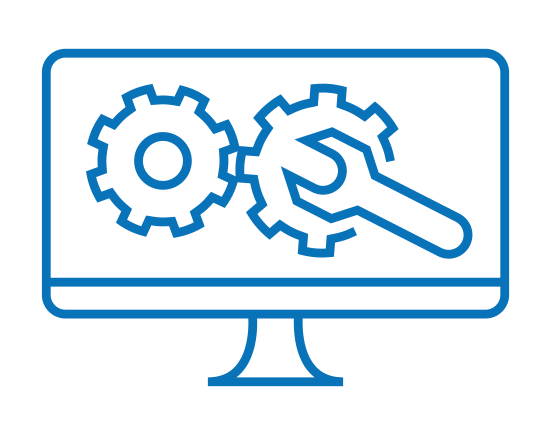
Industry glossary
The Industry Glossary covers the most common terms and abbreviations used in the industries serviced by ERIKS, such as primary industry, food and pharma, energy and transport industry or machine construction. Read the Glossary
5. Frequent causes of bearing damage
A bearing is generally usable up to the end of the rolling fatigue life, but it can also fail earlier due to improper fitting,
mounting, lubrication or handling. The main failure modes and their sub-causes are described in the ISO 15243 standard, and are
based on the damages visible on the rolling element contact surfaces or on other functional surfaces of the bearings.
These failure modes include:
Fatigue, which can be surface-initiated or sub-surface
initiated
Wear, which includes abrasive wear and adhesive wear
Corrosion, which includes moisture corrosion and friction
corrosion (with sub-causes fretting corrosion and false brinelling)
Electrical erosion, which includes excessive voltage and
current leakage
Plastic deformation, which includes overload, indentation
from debris and indentation from handling
Fracture and cracking, which includes forced fracture, fatigue
fracture and thermal cracking
Fatigue occurs due to repeated stress on the contact surfaces between the rolling elements and the raceways, and
leads to changes in material structure. It is visible as spalling or flaking and is mostly surface initiated, the cause for this
type of damage being usually an inadequate lubrication. Sub-surface initiated fatigue is rare and occurs after very long running
times. To prevent this type of damage, the grease type and condition as well as the sealing and loading conditions should be
checked and adjusted as needed.
Wear occurs when fine foreign material gets into the bearing assembly. Such material can be sand or fine metal
particles from grinding or machining, as well as metal particles from gears wear. These foreign particles can cause internal
clearance and misalignment, reducing the life of the bearing. A solution for preventing this type of damage is to add seals to the
bearing assembly, or to use bearing units with polymer cages. Also, changing the type of grease might help.
Corrosion occurs when water or corrosive agents get inside the bearing units in large quantities. When this
happens, the lubricant can no longer provide proper protection, therefore rust forms. Frictional corrosion happens when there are
micro movements between the bearing surfaces, under certain conditions, for example when there is movement between a bearing ring
and a shaft. This causes small particles to become detached from the surface. When exposed to oxygen, the particles oxidize, leading
to bearing damage.
Electrical erosion appears when electric current passes through the bearing. It can be caused by earth return
devices which aren’t working properly or by earth connections which are improperly done when welding.
Plastic deformation can be caused by different factors, such as overload as a result of static or shock loads, or
indentation from debris or improper handling. Incorrect mounting, blows to the rolling elements, cage or rings, foreign particles
that enter the bearing cavity can all cause plastic deformation.
Fracture and cracking can occur when there’s excessive load on the bearing, as a result of improper mounting or
handling, or because the bearing size and capacity are not adequate for the application. This type of damage can also manifest as
thermal cracking, which occurs in the inner or outer ring when the sliding movement causes high frictional heating.
The table below lists some of the most common conditions you can observe in damaged bearings, as well as the potential causes
and the solutions for these types of damage.
| Observed condition | Potential cause of failure | Solution |
|---|---|---|
| Flaking of the raceway surface | Flaking may be caused by excessive load, poor shaft or housing accuracy, poor installation or ingress of foreign objects. | If the load is too heavy, use a bearing with a larger capacity. If needed, use an oil with higher viscosity, or improve the lubrication system to form a protective film. |
| Peeling of the rolling surfaces | More likely to occur when lubrication is poor or the surfaces of opposite parts are rough. It may develop into flaking. | Control the surface roughness and choose a better lubricant. |
| Spalling on the ribs or raceway surfaces | May be caused by poor mounting, poor lubrication of the rolling elements or discontinuation of the protective film on the contact surfaces due to excessive load. | Improve the mounting, correct the load and select an adequate lubricant. |
| Smearing on the raceway surface | The rolling elements slip during the motion and the lubricant doesn't have the right characteristics to prevent slippage. | Select a proper lubricant or lubrication system and check the clearance and pre-load. |
| Raceway surface is worn and dimensions are reduced | Poor lubrication, ingress of a foreign object or contamination of lubricant with dirt or foreign objects. | Choose a proper lubricant or lubrication system, and improve the sealing efficiency. |
| Changes in surface colour and finish | A matted raceway surface or a discoloured surface may indicate poor lubrication, overheating or accumulation of deteriorated oil. | Improve the sealing efficiency and lubrication system, remove the oil with an organic solvent and polish with sandpaper to remove the roughness. |
| Indentations and hollows in the raceway surface | Probably caused by ingress of a solid object or by trapped particles. | Remove and keep out foreign objects, check for flakings and improve the handling procedures. |
| Chipping of the inner ring, outer ring or rolling elements | Chipping may be caused by excessive load, poor handling or trapped solid objects. | Check and improve the load, and improve the sealing efficiency. |
| Cracking in the rings or rolling elements | Excessive load, impact or overheating. A loose fit could also be the cause. | Examine and improve the load and correct the fit. |
| Rust or corrosion of the rings or rolling elements | Moisture, ingress of water or corrosive substances, or poor packing and storing conditions. | Improve the sealing efficiency, handling and storage. |
| Seizing of the rings or rolling elements | Poor heat dissipation due to poor lubrication or a too small clearance. Excessive load can also be the cause. | Improve the dissipation of heat and the lubrication. Check and improve the load. |
| Fretting of the raceways | Too much vibration, a small oscillation angle or poor lubrication. | The inner and outer ring should be transported separately, or the lubrication should be improved. |
| Damage of the cages | Excessive load, too high speed or large fluctuation of speed, poor lubrication or high vibration. | Improve the load conditions, reduce the vibration and improve the lubrication system. |

Do you have questions about our products?
For personal advise and product knowledge, visit an ERIKS location near you or contact our product specialists.
Find a service center | Call our Customer support | Send us an e-mail
